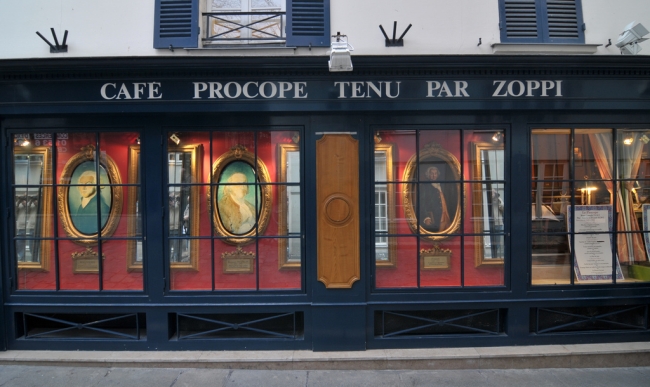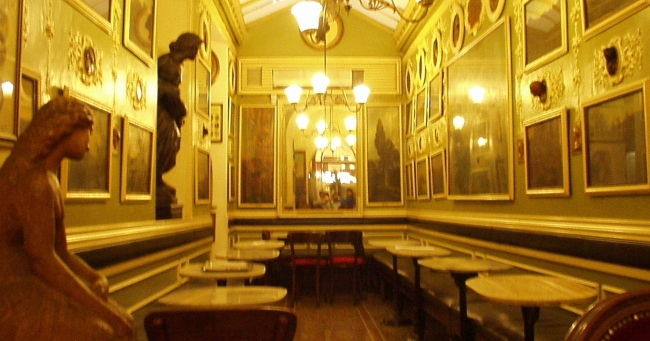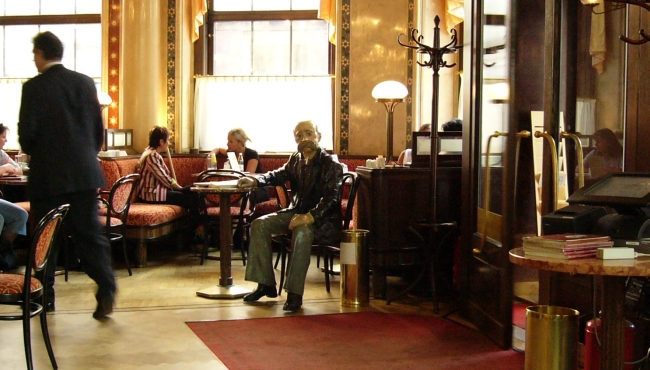A Brief History Of Coffee Houses as Meeting Places
0 Comments
- Posted in:
- General

An Ottoman Coffee House
Throughout history, coffee houses have served as meeting places for the world's politicians, poets, authors and intellectuals. The first recorded political gatherings at coffee houses occurred in Mecca. At the time, Muslim beliefs described coffee as a " /> Coffee shops have been grabbing our attention as of late. We always hear good things from our customers about the Kiln Room, a boardroom adjacent to the The Woods Coffee shop. The atmosphere is casual and inviting, the wifi bandwith plentiful and the coffee, of course, keeps flowing. It's only a theory, but we think that coffee shops like the Woods are successful so successful on our site is because, ever since the first coffee houses sprung up in the Middle East, coffee has always been associated not only with meetings, but the exchange and flowering of new ideas. We did a little research on the topic, and thought we'd share a bit of the coffeehouse's rich history with you.Holy Drink/Devil's Drink
Since Islam expressly prohibits the consumption of alcohol, it only seemed natural that instead of taverns and wine-sinks coffeehouses became the gathering places of choice in the Middle East. Indeed, coffee became so beloved in the Islamic world that Sufis often praised its stimulating effects for keeping one alert during long prayer recitations. There's even a story from Persia (Not in the Koran) that says Muhammad was first served the drink--a potion as "black as the black stone in Mecca"--by the angel Gabriel when he was feeling ill. Murad IV. Better Stick to Decaf.
Murad IV. Better Stick to Decaf.
European Coffee Houses
For centuries, water in Europe was often too unsanitary to drink, so a common alternative was alcohol--a lot of it. It was not uncommon for someone to have a few light beers in the morning, beer for lunch and perhaps mixing it up with some wine or gin in the evening. Essentially, all of Europe was in a drunken haze, morning to night. According to the historian Tom Standage, when the first coffeehouses started springing up in the late 1600's, there was at last an alternative to the perpetual drunken haze, people "who drank coffee instead of alcohol began the day alert and stimulated, rather than relaxed and mildly inebriated, and the quality and quantity of their work improved." In coffeehouses, the people met not to drink and sing, but to exchange ideas, to discuss poetry, philosophy, politics science. One could even argue that coffee was the drink that brought the Enlightenment to Europe. Just like their Middle Eastern counterparts, coffee houses encouraged open discussions about politics, art and intellectual subjects. Patronage of these establishments were discouraged by royalty and government officials, but to no avail. Coffee houses soon became the principal hubs where politicians, artists, writers, and thinkers gathered and exchanged ideas.Notable Cafes
The Cafe de Flore in Paris became a popular meeting place for intellectuals, writers, painters, publishers and filmmakers. Apollinaire, Giacometti, Hemingway, Picasso, Jean-Paul Sartre and Simone de Beauvoir visited the cafe frequently.
Cafe de Flore
The oldest coffee house in Paris, Cafe Procope, was frequented by Voltaire, Benjamin Franklin, Thomas Jefferson, Alexander von Humboldt and George Sand.
Cafe Procope
In Rome, visitors to the Caffe Greco, near the Spanish Steps, included Goethe, Wagner, Mendelssohn, Stendhal, Liszt and Casanova.
Cafe Greco
The creative spirit of Goethe was often inspired by the atmosphere of the coffee house. Writers and artists frequently enjoyed the artistic atmosphere of the Cafe Hawelka in Vienna. Patrons of the Hawelka coffee house included Friedensreich Hundertwasser, Ernst Fuchs, Helmut Qualtinger, Oskar Werner, Nikolaus Harnoncourt, Georg Danzer and Andre Heller.
Cafe Hawelka
The Cafe Central in Vienna was a popular meeting place for the intellectual elite. Chess players, such as Russian revolutionary Leon Trotzky, often engaged in matches and the cafe became known as the "chess school."
Cafe Central
A "Patriotic Drink"
The political and artistic atmosphere of European coffee houses was infused into early American coffee houses as well. The Green Dragon in Boston hosted the greatest thinkers of the 18th century. In 1765, a group of men burned an effigy of Andrew Oliver due to his support of King George III. The next day, the group gathered at the Green Dragon to discuss the burning and other political topics. The group became the Sons of Liberty and the Green Dragon was host to their meetings. Later, as a result of the British taxation of tea, coffee became known as the drink of patriots. The Boston Tea Party was more than a declaration of independence from tea; it was a symbol of the colonists' patriotic support of coffee. The newly formed Continental Congress met at America's most famous coffee house, the Merchant's Coffee House in Philadelphia, where the Declaration of Independence was first read to the public.
Comments